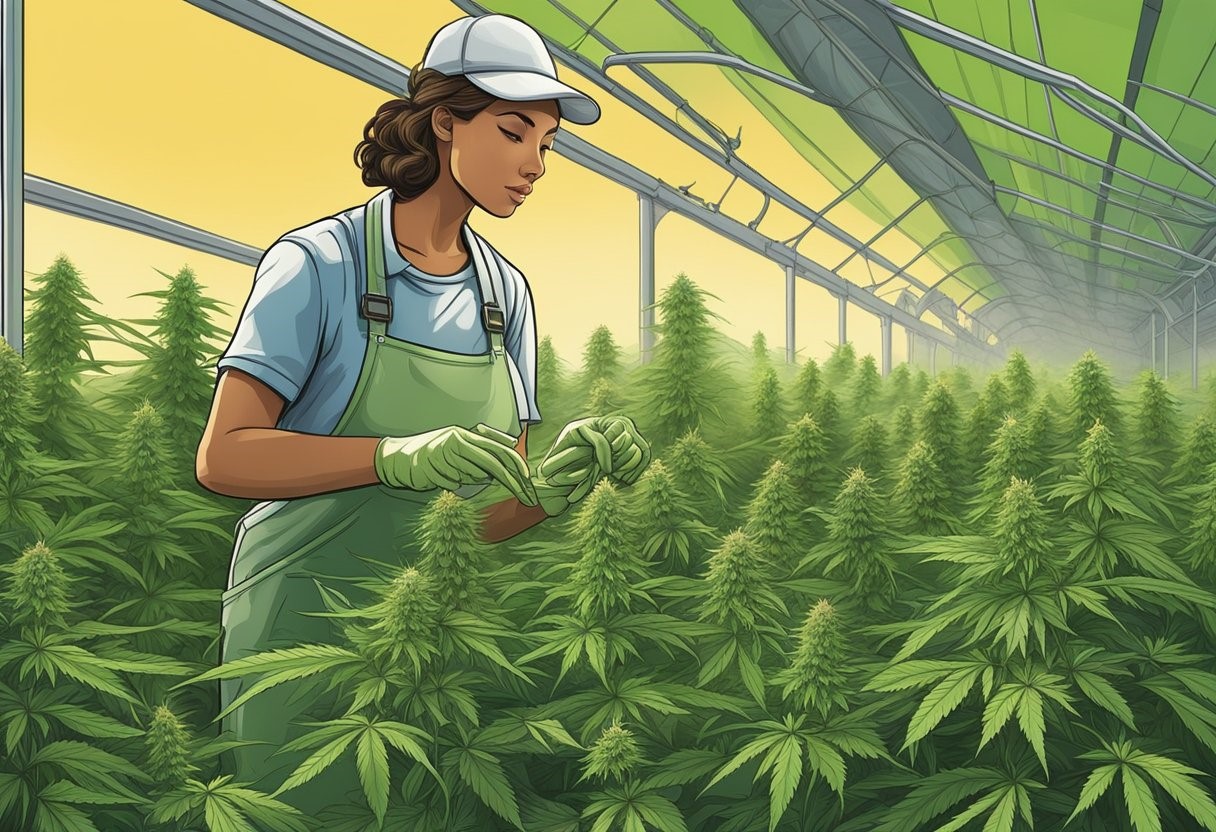
White Widow stands at the pinnacle of popularity for its distinctive blend of potency and balance. Your understanding of its pedigree begins with its enigmatic creation and extends to its well-engineered genetics.
Believed to have originated in Kenya, White Widow’s roots trace back to a powerful landrace strain from this region. Your appreciation for the strain’s vivacity can be attributed to the vibrant and robust genetic pool it hails from—a true gift from nature’s fertile crescent in the realm of cannabis.
White Widow is the progeny of a meticulous crossbreeding process involving an indigenous Kenyan landrace sativa and a resilient Brazillian indica. The result is a genetic makeup that consists of:
This hybridization bestows upon you a balanced concoction that ensures a harmonious synergy of stimulation and relaxation. Its standing as a go-to strain for enthusiasts like you rests on this stable and well-rounded genetic profile.

Your interest in the intricacies of cannabis culture leads you to the White Widow strain, which reflects broader American societal trends. Its popularity is not just about the strain’s properties but also its cultural resonance within the ideals and realities of American life.
You are aware that the American Dream champions individual freedom, and cannabis culture has been intertwined with this ethos. White Widow, in particular, stands as a symbol of the potency and high quality that enthusiasts in America seek, mirroring the pursuit of excellence associated with the American Dream.
In the suburbs, you find a quest for conformity and comfort, and cannabis strains like White Widow slip into this space, offering a subversive yet accessible escape. The strain’s name itself conjures a blend of innocence and edge—paralleling suburban America’s balance between serene facades and the complexities of its residents’ inner lives.
As someone who consumes American media, you notice White Widow’s mentions in song lyrics, film dialogues, and online forums, indicating its imprint on popular culture. Its influence is evident as it embodies a form of rebellion and freedom, themes that are recurrent in American narratives and cherished by audiences across the nation.

White Widow’s bountiful yield and potent effects owe much to meticulous cultivation practices. Your approach to growing this strain can make a significant difference in plant quality and yield.
White Widow thrives in environments that mimic its native climate.
Flowering Time: Indoors, it typically lasts 7-9 weeks. Outdoor growers should be ready for harvest by late October.
To manage large-scale cultivation, your infrastructure must support a controlled environment:
By focusing on the agricultural specifics and establishing robust infrastructure support, your White Widow cultivation will be well-equipped to succeed.
In exploring the popularity of White Widow among American enthusiasts, you must consider the substantial economic contribution of this strain to the cannabis industry. White Widow’s prominence not only reflects cultural acceptance but also contributes to wealth generation and presents financial considerations for growers.
White Widow, a well-known cannabis strain, has been a steady contributor to economic vitality in the cannabis market. Your engagement with this popular variety could support a sector that has seen significant financial growth. The cannabis industry has become an integral part of wealth generation in various states, contributing to job creation and tax revenue.
As a grower, you must weigh the initial investment costs and potential debt against the profitability of cultivating White Widow. This involves:
Efficiently managed, your White Widow crop could offer substantial returns, but fiscal prudence is crucial to navigate financial risks in this industry.
As you explore the world of White Widow and its place among American enthusiasts, it’s important to understand the backdrop of cannabis politics which frames its legality and use.
Your interest in cannabis strains like White Widow is shaped against a shifting political landscape. Under President Donald Trump’s administration, federal cannabis policies remained somewhat ambiguous. While the Trump White House didn’t actively pursue the legalization of marijuana, there was also no significant move to strengthen prohibitions. The Controlled Substances Act still classified marijuana as a Schedule I drug, akin to heroin, in terms of federal law, leading to a complex interplay between federal restrictions and state-level legalization movements.
Your experience with White Widow might vary significantly depending on your location due to changing local and national legislation. States have taken individual stances on marijuana use; some legalizing for medical use, others for recreational. This patchwork regulation across the United States impacts everything from availability to law enforcement. In Washington, policymakers and stakeholders monitor these shifts closely, as the changing tide could dictate national policy in the near future. Legislation at both the state and federal levels continues to evolve, reflecting public opinion and scientific research, making the political landscape of cannabis one to watch.
Understanding the trends behind White Widow’s rise among various American enthusiasts requires a look at societal views and the shifting demographics within the United States. Your grasp of these dynamics is crucial in comprehending its popularity.
White Widow, a strain known for its powerful buzz and energy-inducing effects, is prevalent across diverse family structures in America. White Families often gravitate towards White Widow for its classic status and pervasive presence in the cannabis community. Black Families and Families of Color report a similar affinity to the strain, though their preferences may also be influenced by evolving societal attitudes and the broadening acceptance of cannabis in various cultural milieus.
The popularity of White Widow traverses the demographic landscape, reflecting a common appreciation for its particular experience irrespective of ethnic background. Cannabis use spans across a spectrum of communities, suggesting a unifying thread in the strain’s appeal.
As the demographic makeup of the United States shifts, so do the consumption patterns of cannabis. The gradual decline in the White share of the U.S. population and the concurrent rise in diversity bring about changes in the overall consumption trends.
Cannabis consumption trends are now less predictable and more reflective of a mosaic of American demographics. You’ll find that as communities become more culturally heterogeneous, the patterns of White Widow consumption illustrate a broader societal acceptance cutting across traditional demographic lines.
When you explore the domain of White Widow, a cannabis strain admired by American enthusiasts, it’s crucial to consider the aspects of health and public safety. This will encompass the medical implications of White Widow use and the public concerns surrounding cannabis in relation to terrorism.
White Widow is a balanced hybrid strain known for its potency and high levels of THC. Medical users often gravitate towards White Widow for its potential to relieve:
However, like any other cannabis strain, there are risks associated with its use, especially without proper guidance. You should be aware of potential side effects such as:
The name “White Widow” bears an unfortunate resemblance to Samantha Lewthwaite, infamously dubbed the “White Widow,” who is associated with terrorist groups like Al-Qaeda and ISIS. This coincidence can breed misconceptions related to the strain and its implications in terms of terrorism, which can affect public opinion and safety.
Terrorism: No evidence links the use of White Widow cannabis to terrorism or to violent actions typical of terrorist groups. Cannabis usage is a personal health choice and should not be conflated with activities of criminal entities.
Public Concerns: The association by name has raised public concerns, but it’s important to assess the cannabis strain White Widow on its own merits and risks, unrelated to terrorism. Public safety initiatives prioritize the separation of a substance’s reputation from unrelated geopolitical entities.
Your awareness of White Widow’s impacts and the nuances of its name in the broader context of health and public safety is vital for informed discourse and decision-making.
In this section, you will explore the intricacies of White Widow’s popularity by examining its characteristics versus the Black Widow strain and considering the consumption trends in the United States compared to other nations.
White Widow and Black Widow are two potent strains recognized in cannabis circles for their distinctive effects and genetic makeup. White Widow is renowned for its balanced effects, which offer a powerful burst of euphoria and energy. It has a distinctive flavor profile with a pine-fresh and floral scent.
On the other hand, Black Widow is often described as having a more intense, sedative effect and a sweet-skunky aroma. While the White Widow might be more suited for social and creative activities due to its cerebral effects, Black Widow typically provides a strong body relaxation, making it suitable for those looking to unwind or need help managing pain.
The popularity of the White Widow strain in the United States is reflective of its status worldwide. However, the level of consumption and appreciation can vary.
When exploring the cannabis market, you’ll notice distinct trends and nuances in consumer behavior. White Widow’s sustained popularity is a perfect case study of these patterns.
White Widow has remained a prominent strain in the American cannabis market due to its consistent quality and balanced effects. You’re likely to find that White Widow holds a reputation for a reliably potent hybrid experience—offering a mix of cerebral and physical highs. This consistency has made it a go-to choice among enthusiasts:
Uncertainty plays a crucial role in your preferences, especially in markets with rapidly evolving options like cannabis. White Widow has stood out as a familiar option in an otherwise fluctuating market. Here’s how uncertainty shapes behavior:
In examining the popularity of White Widow among American enthusiasts, it’s essential to consider the historical context in which cannabis trade was influenced. You will uncover how the remnants of slavery and exploitation reverberate through the cannabis trade and how modern global conflicts, such as the rise of Al-Shabaab, are connected to these colonial legacies.
The cannabis trade is not immune to the echoes of slavery and exploitation. The crop that has become synonymous with relaxation and enjoyment for many Americans, has a background tainted by the same colonial systems that bolstered economies through the painful legacy of slaves. For example, in Philadelphia, a hub for American colonial power, figures like George Washington were both leaders of a new country and participants in slavery, which provided labor for various forms of agriculture, including hemp production, a cannabis variant.
Despite the abolition of slavery, the scars of forced labor and exploitation run deep and have historically influenced global trade patterns. Cannabis, once an agricultural product, now symbolizes freedom and innovation but carries the weight of this past.
Al-Shabaab, your awareness of this Islamist militant group is essential as it represents the modern-day consequence of colonial meddling in regions like Kenya. The rise of Al-Shabaab cannot be fully explained without understanding the power vacuums and state weaknesses that were, in part, due to the arbitrary borders and governance systems left behind by colonial powers.
As you follow these events, you gauge that the challenges faced by contemporary Kenyan society and the threats posed by Al-Shabaab have roots in the global history of exploitation. Colonial legacies have laid the foundations that allow such groups to thrive by exploiting disenfranchised populations and leveraging unresolved conflicts.
In this section, you’ll explore the complex relationship between urbanization trends and societal challenges that have emerged, particularly focusing on the shifting dynamics within American suburbs and cities.
Inner-ring suburbs were once the coveted symbol of American success. However, these areas are now facing a collapse of the social contract marked by a decline in infrastructure and community investment. When you examine the story of these suburbs, you see a tale of neglected public spaces and dwindling communal bonds, once vibrant neighborhoods slowly eroding. The decrease in the white population that had fled the cities after World War II has gradually given rise to diverse communities grappling with a lack of supportive frameworks that once made the suburbs highly desirable.
A reconsideration of the social contract – the implicit agreement among residents to support mutual prosperity through taxes and civic engagement – is vital for the revival of these suburbs.
The phenomenon of white flight refers to the migration of white residents from urban centers to suburbs in the mid-20th century, while a reverse trend has seen a return to urban areas for amenities and employment opportunities. These cycles reflect the ongoing change in preferences and economic conditions that influence where people choose to live.
The dynamic changes in where the white population resides have reshaped the social and economic fabric of both the cities they leave behind and the suburbs they inhabit. Your understanding of these patterns is crucial for grasping the broader narrative of urbanization and its discontents.
The rise in White Widow’s popularity brings to light the necessity of education and awareness about cannabis. Understanding its history and the importance of credible information shapes your perspective on its use and cultural significance.
When schools include the history of cannabis, they provide you with the context necessary to appreciate strains like White Widow. You learn about the origins and cultural shifts that have influenced the perception of cannabis over time. This knowledge helps to break down stereotypes and encourages a more nuanced understanding of its role in society.
The use of primary sources in cannabis education ensures the information you receive is grounded in evidence and firsthand accounts. Primary sources, such as research studies and historical documents, allow you to:
By evaluating these sources critically, you develop an informed understanding of White Widow’s place within the broader cannabis industry.
As trends evolve, your understanding of White Widow and its position in American culture must keep pace to stay informed.
Stay Informed: Keep abreast of legislative changes, as these will influence how you can cultivate, purchase, and use White Widow. Acquire knowledge of your local laws to ensure compliance.
Community Engagement: Enhance your experience by participating in local cannabis communities. Here, you can discuss cultivation tips and the latest trends related to White Widow strains.
Breeding Advances: Look out for new variants of White Widow, as cultivators are continuously breeding to enhance its potency, flavor, and growth characteristics.
Scientific Research: Anticipate studies that could uncover additional medicinal benefits or uses of White Widow, potentially contributing to an increase in its popularity and therapeutic application.
White Widow is renowned for its potent cerebral high, characterized by bursts of energy, euphoria, and heightened sensory perception. This strain typically induces a balance of relaxation and stimulation.
Originating from the Netherlands in the 1990s, White Widow quickly gained acclaim for its robust flavor and strong genetic profile, created by crossing a Brazilian sativa landrace with a South Indian indica.
White Widow stands out with its high THC content, ranging between 18-25%, putting it in the higher potency bracket compared to many other cannabis strains available on the market.
To maximize the yield and potency of White Widow, it thrives best in controlled conditions with adequate light, soil pH monitoring, and proper pruning. It’s known for its resilience and suitability for both indoor and outdoor cultivation.
White Widow is often sought for medical purposes, such as managing stress, anxiety, pain, and insomnia. However, the effectiveness varies by individual, and you should consult with a healthcare professional before use.
We ship and deliver world wide via USPS and various couriers.
We offer a wide range of secure and anonymous online payment options.
We care about you, our customer. Please contact us with any questions or concerns.
Find out more about the benefits of being a loyal and regular customer.
WE ARE EVERY GROWERS ONE STOP SHOP TO ACQUIRE PREMIUM CANNABIS SEEDS FOR SALE IN THE USA, CANADA AND AUSTRALIA

Farmers Lab Seeds 2024, | All Right Reserved
Seeds are sold as novelty items, souvenirs, and collectibles. They contain 0% THC. We encourage our customers to check the legislation in their Country, State, Province, and Municipality prior to purchasing items from our store. We do not provide growing information.
All seeds are sold as hemp, and lab tested under 0.3% THC. This product is not for use by or sale to persons under the age of 21. This product should be used only as directed on the label. It should not be used if you are pregnant or nursing. Consult with a physician before use if you have a serious medical condition or use prescription medications. A Doctor’s advice should be sought before using this and any supplemental dietary product. All trademarks and copyrights are property of their respective owners and are not affiliated with nor do they endorse this product.
These statements have not been evaluated by the FDA. This product is not intended to diagnose, treat, cure or prevent any disease. Individual weight loss results will vary. By using this site, you agree to follow the Privacy Policy and all Terms & Conditions printed on this site. Void Where Prohibited by Law.